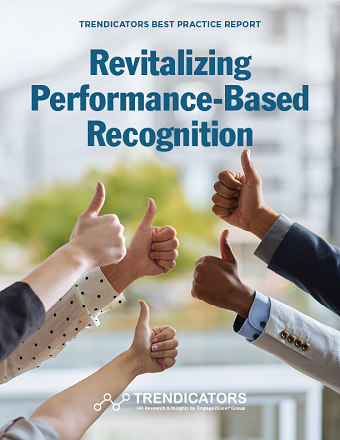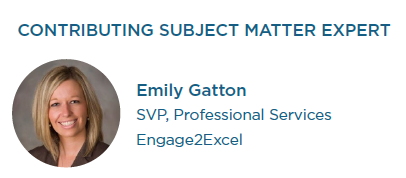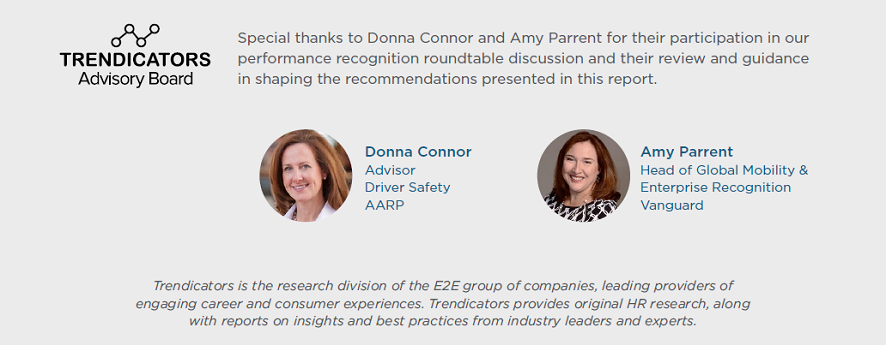Revitalizing Performance-Based Recognition

Introduction
Organizations across all industry sectors face significant challenges in optimizing employee performance amid a difficult post-pandemic business environment. The S&P 500 plunged nearly 9% in April, inflation is at its highest rate in 40 years, and labor shortages are driving workforce concerns to the top of the CEO’s agenda. To address these challenges, many HR leaders are seeking ways to revitalize performance-based recognition programs.
On April 19, 2022, Trendicators, the research division of the Engage2Excel Group, conducted a roundtable discussion with members of the Trendicators Advisory Board to discuss how performance recognition programs can address today’s workforce challenges. Emily Gatton, Engage2Excel’s SVP for Professional Services, led off the discussion with an overview of the current state of performance management programs. Advisory Board members then shared their experiences, challenges and successes in a lively conversation that helped shape the contents of this report.
 Emily Gatton is an expert in the design and implementation of recognition programs to achieve strategic business objectives. She enjoys 16 years of experience creating solutions for organizations of every size and vertical. Emily leads Engage2Excel’s solution design, communications and implementation teams and consults with clients on maximizing impact and delivering innovative solutions that increase engagement, performance and retention.
Emily Gatton is an expert in the design and implementation of recognition programs to achieve strategic business objectives. She enjoys 16 years of experience creating solutions for organizations of every size and vertical. Emily leads Engage2Excel’s solution design, communications and implementation teams and consults with clients on maximizing impact and delivering innovative solutions that increase engagement, performance and retention.

Download
 hbspt.cta.load(123973, '828adcc9-acda-479d-b196-b0064cbde2c4', {"useNewLoader":"true","region":"na1"});
hbspt.cta.load(123973, '828adcc9-acda-479d-b196-b0064cbde2c4', {"useNewLoader":"true","region":"na1"});
What Is Performance Recognition?
Performance-based employee recognition is the process of identifying, recognizing and rewarding behaviors that are aligned with the achievement of measurable business outcomes. Unlike programs that recognize and reward employees for their tenure, performance recognition programs are designed to reinforce particular behaviors, practices or activities, which result in better performance outcomes and positive business results.
Is the Annual Performance Review Disappearing?
Annual performance reviews are experiencing an evolution. In their place we are seeing more frequent check-ins, like one-on-one meetings, as a great way to discuss performance and goals in real-time — keeping employees engaged, fostering trust, and giving employees ownership of their own experience and performance.
Performance Recognition Advantages
Today’s employees are looking for meaning and purpose. They want feedback on how they are doing, and they crave recognition. A 2022 Trendicators nationwide survey revealed that the most common reason employees seek employment elsewhere is a lack of recognition, appreciation and respect.
Performance recognition programs help align employee behaviors with key strategic objectives and enable companies to provide positive reinforcement for improvements throughout the year. When effectively designed and implemented, these programs help foster a high-performance culture and deliver a measurable ROI.

Download
 hbspt.cta.load(123973, '828adcc9-acda-479d-b196-b0064cbde2c4', {"useNewLoader":"true","region":"na1"});
hbspt.cta.load(123973, '828adcc9-acda-479d-b196-b0064cbde2c4', {"useNewLoader":"true","region":"na1"});
How Has Performance Recognition Evolved?
The practice of recognizing and rewarding employees dates to the late 1800s. Engage2Excel, the longest continuously operating employee recognition company in the U.S., was founded in 1892 as The Robbins Company (then Tharpe-Robbins), manufacturing employee recognition pins, plaques and jewelry. Fast forward, they have evolved into an industry-leading provider of employee recognition programs, recruitment solutions, and engagement and experience surveys.
Today, the employee recognition market is valued at $75B, with nearly 90% of companies offering recognition programs.
Over the past decade, software-as-a-service (SaaS) platforms have made it easy for companies of all sizes to implement and manage recognition programs, with the social recognition segment growing at an annual compound rate of 14%.
Results-Driven Innovation
While the impact of recognition on employee engagement and retention is well documented, recent innovation has focused on the alignment between specific organizational goals and initiatives that drive changes in behavior to increase competitive advantage and improve measurable business results.
Expanding the Reach and Relevance of Recognition Through Performance Programs
According to Emily Gatton, Engage2Excel’s SVP of Professional Services, there has been a shift in performance-based recognition program design. Rather than simply focusing on top-tier performers and champions, employers are expanding programs to reach a broader employee population base to drive real organizational change. She says, “If you want to drive performance metrics, you need to focus on the middle of the bell curve and create a greater variety of programs to motivate individuals and teams throughout the organization.”
A recent survey revealed that 65% of employees reported not having been recognized for their performance over the past year. Roy Saunderson, Engage2Excel’s Chief Learning Officer, advises clients that for recognition to be effective and meaningful, it needs to be connected to a specific achievement and be delivered promptly. Performance recognition programs offer a way for HR leaders to answer the need employees have for meaningful recognition while advancing certain organizational objectives.
Download
 hbspt.cta.load(123973, '828adcc9-acda-479d-b196-b0064cbde2c4', {"useNewLoader":"true","region":"na1"});
hbspt.cta.load(123973, '828adcc9-acda-479d-b196-b0064cbde2c4', {"useNewLoader":"true","region":"na1"});
Designing More Effective & Inclusive Programs
Legacy performance recognition programs have focused on rewarding the achievement of specific milestones or recognizing the highest achieving individuals, teams or departments. Such programs, however, often overlook the acknowledgment of incremental improvements within the broader population. Points-based rewards programs can be designed to engage all employees who qualify for participation. This helps build a more inclusive culture focused on enterprise-wide performance improvement.
Benefits of Points-Based Rewards
When employees can earn and accumulate points tied to a performance recognition program, incremental improvements can be more widely recognized. Employees collect points over time that they can use to redeem higher-value rewards of their choice. Unlike programs that only recognize top performers, points-based recognition programs provide managers with the discretionary opportunity to acknowledge performance improvement across a broader base of their direct reports.
Points-based performance recognition programs keep a wide variety of participants engaged and motivated and are easy to track and manage.
Tips for Designing More Effective Performance Recognition Programs
- Review your organization’s top strategic priorities for change management and performance improvement.
- Pick initiatives that can be influenced by increased levels of discretionary effort by employees.
- Define the specific behaviors the program seeks to influence.
- Identify both qualitative and quantitative metrics for benchmarking performance improvement.
- Calculate the business impact of various levels of performance improvement.
- Increase engagement through challenges and frequent communications to incorporate recognition into daily work.
- Understand that performance recognition programs are an investment in change management. HR teams need to engage business leaders to identify the current state and improvement targets, which will generate the data required to document progress and business impact.
Download
 hbspt.cta.load(123973, '828adcc9-acda-479d-b196-b0064cbde2c4', {"useNewLoader":"true","region":"na1"});
hbspt.cta.load(123973, '828adcc9-acda-479d-b196-b0064cbde2c4', {"useNewLoader":"true","region":"na1"});
The Manager’s Role in Performance Recognition
Managers play a vital role in delivering recognition. Employees are looking for a greater sense of purpose and connection in today’s post-pandemic work environment. Making recognition personal and relevant, and celebrating achievements small and large, is critical, especially with such a large proportion of the workforce continuing to work remotely either full- or part-time. Unfortunately, few organizations measure manager effectiveness in delivering recognition. While modern platforms automate processes for recognizing and rewarding employees, few are designed to hold managers accountable for providing effective recognition.
Ensuring Accountability: One challenge program owners face is getting managers to recognize and reward employees promptly. Take, for example, an organization that gives managers 1,000 points to award employees over a month. Manager A awards them consistently throughout the month, whereas Manager B waits until the end of the month for fear of being chastised for “failure to recognize.” One way to address this is to educate managers that recognizing positive behavior when it occurs has a significantly greater influence than a delayed response.
Utilizing Budgets: Another challenge is that some managers fail to utilize their budgets for rewards. In our roundtable discussion, one advisor observed that managers used only 35% of the available points budget in the first quarter of this year. Promoting the importance of performance recognition programs and enlisting the support of your senior leadership to reinforce participation is critical.
Incentivizing Managers: Managers are under constant pressure and often do not think about prioritizing recognition in their daily routines. One option to consider in designing your programs is adding recognition and rewards for managers who actively participate and utilize 100% of their allocated budgets.
Making Recognition Personal: An important trend that has evolved since the pandemic is the personalization of rewards beyond the points system. A spa day for an employee who is overstressed, or an impromptu team outing, sends the message to individuals that they are important and appreciated. In all cases, it is important for managers to recognize specific actions or behaviors and their positive impact on organizational goals.
Download
 hbspt.cta.load(123973, '828adcc9-acda-479d-b196-b0064cbde2c4', {"useNewLoader":"true","region":"na1"});
hbspt.cta.load(123973, '828adcc9-acda-479d-b196-b0064cbde2c4', {"useNewLoader":"true","region":"na1"});
Promoting Performance Recognition Programs
Building awareness for your employee recognition program drives employee engagement and program participation, and it helps individuals see that the company values their contributions. The following is an outline to use in building your performance recognition plan.
Define your target audience & goals:
- What business outcomes do you seek to achieve?
- What employee groups or departments will you target?
- What behaviors do you seek to influence?
Engage your marketing team:
- Create a program brand
- Build a communications plan
- Define communications channels, themes and messages
- Create e-Cards for social recognition
Stage a kickoff event:
- Invite executive sponsors and all employees
- Communicate program goals and incentives
- Distribute promotional materials
Launch a multi-channel campaign:
- Targeted emails
- Intranet posts
- Newsletter articles
- Social recognition channels
- On-site posters
Celebrate program success:
- Share success metrics
- Recognize all program participants through their preferred channels
- Enlist executive leadership to recognize and amplify success
- Stage a virtual or on-site recognition event
Evaluate areas for improvement:
- Analyze participation rates and business impact
- Survey managers and employees
- Reassess budget and ROI
Download
 hbspt.cta.load(123973, '828adcc9-acda-479d-b196-b0064cbde2c4', {"useNewLoader":"true","region":"na1"});
hbspt.cta.load(123973, '828adcc9-acda-479d-b196-b0064cbde2c4', {"useNewLoader":"true","region":"na1"});
Profiles in Performance Recognition Success
The following are examples of how organizations use performance recognition to motivate and incentivize employees.
Mission, vision and values: The most popular types of programs recognize the behaviors and actions that demonstrate an organization’s mission, vision and values.
Technology adoption: A significant challenge all companies face when rolling out a new technology platform is user adoption. Performance recognition programs can accelerate the adoption rate by incentivizing participation in training and demo sessions and rewarding “platform champions” who help train teammates in their department.
Worker safety: A field services company with hundreds of mobile technicians noticed a rise in vehicle-related insurance claims. Beyond the cost of such claims, this also negatively
impacted productivity and represented a safety risk for drivers. Research revealed an increase in the number of mobile technicians who weren’t passing their roadside safety inspections. The company designed a performance recognition program to reward drivers for passing their safety inspections. As a result, insurance claims went down and safety and mobile technician productivity improved, resulting in a significant ROI.
Sales: A professional services company sought to increase its outreach to smaller clients with specialized needs. Individually, these clients don’t represent a significant commission opportunity for sales reps. However, in aggregate, this segment offered excellent growth potential. The company created a performance recognition program using a group reward model to motivate outreach activities. T-shirts were created and the program was promoted in sales meetings and via the company’s recognition platform. Team goals were set for outreach activities, and teams were recognized and rewarded based on their level of achievement. By incentivizing teams, the program resulted in a significant uptick in activity with an underserved customer segment.
Patient safety: Medical errors are a concern for all health care institutions. To address this problem, many health care institutions have created Good Catch programs to recognize and reward staff for detecting and preventing potentially harmful events. One study of 45 hospitals that implemented Good Catch programs reported a 47% improvement in reporting preventable events.
Download
 hbspt.cta.load(123973, '828adcc9-acda-479d-b196-b0064cbde2c4', {"useNewLoader":"true","region":"na1"});
hbspt.cta.load(123973, '828adcc9-acda-479d-b196-b0064cbde2c4', {"useNewLoader":"true","region":"na1"});